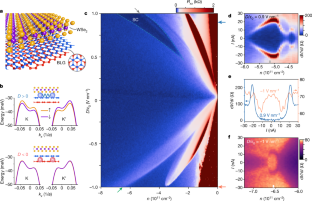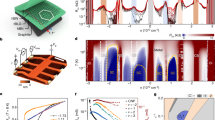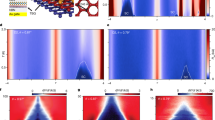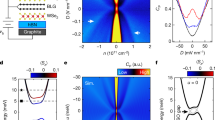Abstract
In the presence of a large perpendicular electric field, Bernal-stacked bilayer graphene (BLG) features several broken-symmetry metallic phases1,2,3 as well as magnetic-field-induced superconductivity1. The superconducting state is quite fragile, however, appearing only in a narrow window of density and with a maximum critical temperature Tc ≈ 30 mK. Here we show that placing monolayer tungsten diselenide (WSe2) on BLG promotes Cooper pairing to an extraordinary degree: superconductivity appears at zero magnetic field, exhibits an order of magnitude enhancement in Tc and occurs over a density range that is wider by a factor of eight. By mapping quantum oscillations in BLG–WSe2 as a function of electric field and doping, we establish that superconductivity emerges throughout a region for which the normal state is polarized, with two out of four spin-valley flavours predominantly populated. In-plane magnetic field measurements further reveal that superconductivity in BLG–WSe2 can exhibit striking dependence of the critical field on doping, with the Chandrasekhar–Clogston (Pauli) limit roughly obeyed on one end of the superconducting dome, yet sharply violated on the other. Moreover, the superconductivity arises only for perpendicular electric fields that push BLG hole wavefunctions towards WSe2, indicating that proximity-induced (Ising) spin–orbit coupling plays a key role in stabilizing the pairing. Our results pave the way for engineering robust, highly tunable and ultra-clean graphene-based superconductors.
This is a preview of subscription content, access via your institution
Access options
Access Nature and 54 other Nature Portfolio journals
Get Nature+, our best-value online-access subscription
$29.99 / 30 days
cancel any time
Subscribe to this journal
Receive 51 print issues and online access
$199.00 per year
only $3.90 per issue
Buy this article
- Purchase on Springer Link
- Instant access to full article PDF
Prices may be subject to local taxes which are calculated during checkout




Similar content being viewed by others
Data availability
The data shown in the main figures are available from the CaltechDATA at https://doi.org/10.22002/wecmz-csm13.
Code availability
The code used to reproduce data plots is available from the CaltechDATA at https://doi.org/10.22002/wecmz-csm13. The code used for the modelling is available upon reasonable request.
References
Zhou, H. et al. Isospin magnetism and spin-polarized superconductivity in Bernal bilayer graphene. Science 375, 774–778 (2022).
de la Barrera, S. C. et al. Cascade of isospin phase transitions in Bernal-stacked bilayer graphene at zero magnetic field. Nat. Phys. 18, 771–775 (2022).
Seiler, A. M. et al. Quantum cascade of correlated phases in trigonally warped bilayer graphene. Nature 608, 298–302 (2022).
Bistritzer, R. & MacDonald, A. H. Moiré bands in twisted double-layer graphene. Proc. Natl Acad. Sci. USA 108, 12233–12237 (2011).
Sharpe, A. L. et al. Emergent ferromagnetism near three-quarters filling in twisted bilayer graphene. Science 365, 605–608 (2019).
Serlin, M. et al. Intrinsic quantized anomalous Hall effect in a moiré heterostructure. Science 367, 900–903 (2019).
McCann, E. Asymmetry gap in the electronic band structure of bilayer graphene. Phys. Rev. B 74, 161403 (2006).
Zhang, Y. et al. Direct observation of a widely tunable bandgap in bilayer graphene. Nature 459, 820–823 (2009).
McCann, E. & Koshino, M. The electronic properties of bilayer graphene. Rep. Prog. Phys. 76, 056503 (2013).
Wang, Z. et al. Origin and magnitude of ‘designer’ spin-orbit interaction in graphene on semiconducting transition metal dichalcogenides. Phys. Rev. X 6, 041020 (2016).
Gmitra, M. & Fabian, J. Proximity effects in bilayer graphene on monolayer WSe2: field-effect spin valley locking, spin-orbit valve, and spin transistor. Phys. Rev. Lett. 119, 146401 (2017).
Khoo, J. Y., Morpurgo, A. F. & Levitov, L. On-demand spin–orbit interaction from which-layer tunability in bilayer graphene. Nano Lett. 17, 7003–7008 (2017).
Khoo, J. Y. & Levitov, L. Tunable quantum Hall edge conduction in bilayer graphene through spin-orbit interaction. Phys. Rev. B 98, 115307 (2018).
Island, J. O. et al. Spin–orbit-driven band inversion in bilayer graphene by the van der Waals proximity effect. Nature 571, 85–89 (2019).
Wang, D. et al. Quantum Hall effect measurement of spin–orbit coupling strengths in ultraclean bilayer graphene/WSe2 heterostructures. Nano Lett. 19, 7028–7034 (2019).
Li, Y. & Koshino, M. Twist-angle dependence of the proximity spin-orbit coupling in graphene on transition-metal dichalcogenides. Phys. Rev. B 99, 075438 (2019).
Zhou, H., Xie, T., Taniguchi, T., Watanabe, K. & Young, A. F. Superconductivity in rhombohedral trilayer graphene. Nature 598, 434–438 (2021).
Dong, Z., Davydova, M., Ogunnaike, O. & Levitov, L. Isospin ferromagnetism and momentum polarization in bilayer graphene. Preprint at https://arxiv.org/abs/2110.15254 (2021).
Huang, C. et al. Spin and orbital metallic magnetism in rhombohedral trilayer graphene. Preprint at https://arxiv.org/abs/2203.12723 (2022).
Lu, J. M. et al. Evidence for two-dimensional Ising superconductivity in gated MoS2. Science 350, 1353–1357 (2015).
Saito, Y. et al. Superconductivity protected by spin-valley locking in ion-gated MoS2. Nat. Phys. 12, 144–149 (2016).
Xi, X. et al. Ising pairing in superconducting NbSe2 atomic layers. Nat. Phys. 12, 139–143 (2016).
Fatemi, V. & Ruhman, J. Synthesizing Coulombic superconductivity in van der Waals bilayers. Phys. Rev. B 98, 094517 (2018).
Chou, Y.-Z., Wu, F. & Sarma, S. D. Enhanced superconductivity through virtual tunneling in bernal bilayer graphene coupled to WSe2. Preprint at https://arxiv.org/abs/2206.09922 (2022).
Dong, Z. & Levitov, L. Superconductivity in the vicinity of an isospin-polarized state in a cubic Dirac band. Preprint at https://arxiv.org/abs/2109.01133 (2021).
Ghazaryan, A., Holder, T., Serbyn, M. & Berg, E. Unconventional superconductivity in systems with annular fermi surfaces: application to rhombohedral trilayer graphene. Phys. Rev. Lett. 127, 247001 (2021).
Qin, W. et al. Functional renormalization group study of superconductivity in rhombohedral trilayer graphene. Preprint at https://arxiv.org/abs/2203.09083 (2022).
You, Y.-Z. & Vishwanath, A. Kohn-Luttinger superconductivity and intervalley coherence in rhombohedral trilayer graphene. Phys. Rev. B 105, 134524 (2022).
Cea, T., Pantaleón, P. A., Phong, V. T. & Guinea, F. Superconductivity from repulsive interactions in rhombohedral trilayer graphene: a Kohn-Luttinger-like mechanism. Phys. Rev. B 105, 075432 (2022).
Chou, Y.-Z., Wu, F., Sau, J. D. & Sarma, S. D. Acoustic-phonon-mediated superconductivity in rhombohedral trilayer graphene. Phys. Rev. Lett. 127, 187001 (2021).
Chou, Y.-Z., Wu, F., Sau, J. D. & Das Sarma, S. Acoustic-phonon-mediated superconductivity in Bernal bilayer graphene. Phys. Rev. B 105, L100503 (2022).
Arora, H. S. et al. Superconductivity in metallic twisted bilayer graphene stabilized by WSe2. Nature 583, 379–384 (2020).
Lake, E., Patri, A. S. & Senthil, T. Pairing symmetry of twisted bilayer graphene: a phenomenological synthesis. Phys. Rev. B 106, 104506 (2022).
Cao, Y. et al. Unconventional superconductivity in magic-angle graphene superlattices. Nature 556, 43–50 (2018).
Park, J. M., Cao, Y., Watanabe, K., Taniguchi, T. & Jarillo-Herrero, P. Tunable strongly coupled superconductivity in magic-angle twisted trilayer graphene. Nature 590, 249–255 (2021).
Hao, Z. et al. Electric field–tunable superconductivity in alternating-twist magic-angle trilayer graphene. Science 371, 1133–1138 (2021).
Zhang, Y. et al. Promotion of superconductivity in magic-angle graphene multilayers. Science 377, 1538–1543 (2022).
Park, J. M. et al. Robust superconductivity in magic-angle multilayer graphene family. Nat. Mater 21, 877–883 (2022).
David, A., Rakyta, P., Kormányos, A. & Burkard, G. Induced spin-orbit coupling in twisted graphene–transition metal dichalcogenide heterobilayers: twistronics meets spintronics. Phys. Rev. B 100, 085412 (2019).
Naimer, T., Zollner, K., Gmitra, M. & Fabian, J. Twist-angle dependent proximity induced spin-orbit coupling in graphene/transition metal dichalcogenide heterostructures. Phys. Rev. B 104, 195156 (2021).
Zibrov, A. A. et al. Robust fractional quantum Hall states and continuous quantum phase transitions in a half-filled bilayer graphene Landau level. Nature 549, 360–364 (2017).
Taychatanapat, T., Watanabe, K., Taniguchi, T. & Jarillo-Herrero, P. Electrically tunable transverse magnetic focusing in graphene. Nat. Phys. 9, 225–229 (2013).
Yang, B. et al. Strong electron-hole symmetric Rashba spin-orbit coupling in graphene/monolayer transition metal dichalcogenide heterostructures. Phys. Rev. B 96, 041409 (2017).
Amann, J. et al. Counterintuitive gate dependence of weak antilocalization in bilayer graphene/WSe2 heterostructures. Phys. Rev. B 105, 115425 (2022).
Banszerus, L. et al. Extraordinary high room-temperature carrier mobility in graphene-WSe2 heterostructures. Preprint at https://arxiv.org/abs/1909.09523 (2019).
Acknowledgements
We thank A. Young and A. Macdonald for fruitful discussions. This work has been primarily supported by NSF-CAREER award (no. DMR-1753306), and the Office of Naval Research (grant no. N142112635) and the Army Research Office (grant award no. W911NF17-1-0323). Nanofabrication efforts have been in part supported by the Department of Energy DOE-QIS program (DE-SC0019166). S.N.-P. acknowledges support from the Sloan Foundation (grant no. FG-2020-13716). J.A. and S.N.-P. also acknowledge the support of the Institute for Quantum Information and Matter, an NSF Physics Frontiers Center with support of the Gordon and Betty Moore Foundation through grant no. GBMF1250. C.L. and E.L.-H. acknowledge support from the Gordon and Betty Moore Foundation’s EPiQS Initiative, grant no. GBMF8682.
Author information
Authors and Affiliations
Contributions
Y.Z. and S.N.-P. designed the experiment. Y.Z., R.P. and H.Z. performed the measurements, fabricated the devices and analysed the data. A.T., E.L.-H. and C.L. developed the theoretical models and performed the calculations supervised by J.A. K.W. and T.T. provided the hBN crystals. S.N.-P. supervised the project. Y.Z., A.T., E.L.-H., C.L., H.Z., R.P., J.A. and S.N.-P. wrote the manuscript with the input of other authors.
Corresponding author
Ethics declarations
Competing interests
The authors declare no competing interests.
Peer review
Peer review information
Nature thanks R. Thomas Weitz and the other, anonymous, reviewer(s) for their contribution to the peer review of this work. Peer reviewer reports are available.
Additional information
Publisher’s note Springer Nature remains neutral with regard to jurisdictional claims in published maps and institutional affiliations.
Extended data figures and tables
Extended Data Fig. 1 Quantum oscillations at selected gate points.
a,b, n–D phase diagram with the coloured dots indicating the positions at which the quantum oscillations (left panels in c–m) are taken. c–m, Left panels show the quantum oscillations at the coloured dots. Right panels show the normalized Fourier transform of the corresponding Rxx(1/B⊥) data.
Extended Data Fig. 2 Reproducibility of zero-magnetic-field superconductivity in BLG-WSe2.
a, Schematic of a dual-gated device. Doping density n and D field are controlled by tuning top and bottom gate voltage vt and vb. b,c, Optical images of the investigated devices. The scale bar in each panel corresponds to 10 μm. d,e, Rxx versus doping density n and D field measured from the first device D1 between contacts 1—3 (d) and 2—4 (e). Contacts 1—3 were used for the measurements in the main text. f,g, Rxx versus doping density n measured from the second device D2 at D/ϵ0 = 0.9 V/nm (f) and 1 V/nm (g).
Extended Data Fig. 3 The third superconducting BLG-WSe2 device D3.
a, Rxx versus doping density n and displacement field D measured at zero magnetic field for device D3. b, Rxx versus B⊥ and doping density n for D/ϵ0 = 1.1 V/nm. c, Fourier transform of Rxx(1/B⊥) versus n and fν for D/ϵ0 = 1.1 V/nm. Schematics on top depict the possible Fermi surface structures for the different phases given that spin-valley flavours are not mixed. d, Rxx versus n at zero magnetic field for the same D field. The superconducting phase possesses a flavour-polarized normal state with two majority and multiple (m > 2) minority Fermi pockets (denoted as FP(2, m>2)+). e, Rxx versus density n and temperature showing a superconducting dome at D/ϵ0 = 1.15 V/nm. f, Critical current disappearing with B⊥ field measured at D/ϵ0 = 1.1 V/nm, n = − 6.55 × 10 11cm−2. g, Rxx versus n and B⊥ field around the superconducting region for D/ϵ0 = 1.1 V/nm.
Extended Data Fig. 4 The fourth superconducting BLG-WSe2 device D4.
a, Rxx versus doping density n and displacement field D measured at zero magnetic field for device D4. b, Rxx versus B⊥ and doping density n for D/ϵ0 = 1.1 V/nm. c, Fourier transform of Rxx(1/B⊥) versus n and fν for D/ϵ0 = 1.1 V/nm. Schematics on top depict the possible Fermi surface structures for the different phases given that spin-valley flavours are not mixed. d, Rxx versus n at zero magnetic field for the same D field. The superconducting phase possesses a flavour-polarized normal state with two majority and multiple (m > 2) minority Fermi pockets (denoted as FP(2, m > 2)+). e, Rxx versus density n and temperature showing a superconducting dome at D/ϵ0 = 1.1 V/nm. f, Critical current disappearing with B⊥ field measured at D/ϵ0 = 1.1 V/nm, n = − 6.7 × 10 11cm−2. g, Rxx versus n and B⊥ field around the superconducting region for D/ϵ0 = 1.1 V/nm.
Extended Data Fig. 5 Transverse magnetic focusing with out-of-plane and in-plane magnetic field.
a, Non-local resistance Rnl measured as a function of n and B⊥ at D/ϵ0 = 0.6 V/nm with the configuration shown in c. b, Non-local resistance Rnl measured as a function n and B∥ at D/ϵ0 = − 0.2 V/nm. Transverse magnetic focusing with an in-plane field is due to imperfect sample alignment. Therefore, we can estimate the field misalignment angle by comparing a and b (see Methods for further discussion).
Extended Data Fig. 6 Polarized phases.
a,c—f, Expected normalized quantum oscillation frequencies as a function of density without interactions (a), allowing for U(1)v unbroken states with C3 preserved (c), allowing for U(1)v unbroken states with C3 broken (d), allowing for IVC ordered states with C3 preserved (e), and allowing IVC ordered states with C3 broken (f). Regions with red (blue) backgrounds correspond to singly polarized states that preserve (spontaneously break) the valley symmetry (even when the initial conditions were chosen to allow IVC order to develop, as in e and f). Regions coloured yellow are multiply polarized (no distinction is made between those with and without IVC order). Insets show the Fermi surfaces corresponding to a select set of fillings. The D field is set to D/ϵ0 = 1 V/nm in all plots. All simulations include SOC (λI = 0.7 meV and λR = 3 meV) except for the red curve in a. b, Plot of the difference between the change in ground state energy induced by Ising SOC for an IVC state and the change in ground state energy induced by Ising SOC for a VP state. The energy is normalized by the number of carriers Nf. The negative values obtained imply that the addition of Ising SOC to a VP state increases its energy more than the addition of Ising SOC increases the ground state energy of an IVC ground state.
Extended Data Fig. 7 Fan diagrams at D < 0.
a,b, Rxx versus B⊥ and doping density n for D/ϵ0 = − 1 V/nm (a) and − 0.9 V/nm (b). c,e, Fourier transform of Rxx(1/B⊥) versus n and fν for D/ϵ0 = − 1 V/nm and − 0.9 V/nm, respectively. Rxx data within 0.05 T < B⊥ < 0.6 T are used for converting. The corresponding Rxx data at zero magnetic field are shown in d and f. We note that none of the measured devices showed zero-magnetic-field superconductivity for D < 0 as typically verified down to D/ε0 = − 1 V/nm (and in some instances to D/ε0 = − 1.1 V/nm).
Extended Data Fig. 8 Zero-magnetic-field superconductivity and FP(2, 2)+ phase at D > 0.
a–c, Rxx versus B⊥ and doping density n for D/ϵ0 = 1 V/nm (a), 0.9 V/nm (b), and 0.8 V/nm (c). d,f,h, Fourier transform of Rxx(1/B⊥) versus n and fν for D/ϵ0 = 1 V/nm, 0.9 V/nm, and 0.8 V/nm, respectively. Rxx data within 0.05 T < B⊥ < 0.6 T are used for converting. The corresponding Rxx data at zero magnetic field are shown below (e,g,i). We see a good match between the doping range exhibiting superconductivity and the FP(2, 2)+ phase region, regardless of D fields.
Extended Data Fig. 9 In-plane magnetic field dependence of superconductivity.
a,b, Rxx versus doping density n and temperature for the superconducting domes at D/ϵ0 = 1 V/nm (a) and 1.1 V/nm (b). c,d, Rxx versus n and B∥ for the superconducting domes at D/ϵ0 = 1 V/nm (c) and 1.1 V/nm (d). Red dots indicate the critical temperature at zero magnetic field. e,f, Pauli violation ratio (PVR) calculated from \({B}_{c\parallel }^{T\approx 30\,{\rm{mK}}}/{B}_{p}\) as a function of doping density n. Both curves feature strong Pauli-limit violation at low ∣n∣. Inset of e shows coherence length \({\xi }_{{\rm{GL}}}=\sqrt{{\Phi }_{0}/(2\pi {B}_{c\perp })}\) and ħvF/πΔ versus n at D/ϵ0 = 1 V/nm. ħvF/πΔ is estimated with a weak-coupling assumption: Δ ≈ 1.76kBTc and vF = ħkf/m* (\({k}_{f}=\sqrt{2\pi {f}_{\nu }| n| }\) with fν being the normalized frequency of minority Fermi pockets, m* ~ 0.15me). g–k, Rxx versus temperature and B∥ at different densities for D/ϵ0 = 1.1 V/nm. In-plane critical fields Bc∥ (the field at which Rxx is 50% of the normal state resistance) are marked by dots, and all the data are well-fit by the phenomenological relation. We see a clear evolution of the PVR as a function of doping.
Extended Data Fig. 10 Estimating different SOC strengths through quantum Hall effect and quantum oscillations.
a–e, Rxx versus \(\nu =2\pi {{\ell }}_{B}^{2}n\) (ℓB is the Landau magnetic length) and D field at B⊥ = 1 T, 2 T, 3 T, 5 T, and 7 T, respectively. Arrows mark the transition of ∣ν∣ = 3 quantum Hall states with D field. Because the Ising SOC is oriented out of plane, an out-of-plane Zeeman splitting will cancel it when \(2{E}_{Z}=2g{\mu }_{B}{B}_{\perp }^{* }={\lambda }_{I}\) (\({B}_{\perp }^{* }\) is the magnetic field at which yellow and green arrows are at the same D field; \({B}_{\perp }^{* }\approx 3\) T here). f,g, ΔRxx versus 1/B⊥ (measured up to B⊥ = 5 T) at D/ϵ0 = 0.2 V/nm, n = − 3.5 × 1011cm−2 (f) and D/ϵ0 = − 0.1 V/nm, n = − 20 × 1011 cm−2 (g). The corresponding FFT data are shown in h and i. Inset of h shows the FFT splitting Bsplit (marked by black arrows in the main panel) versus doping density n measured at D/ϵ0 = 0.2 V/nm. Coloured lines show the FFT splitting predicted from band structure calculations for the same D field, using Ising SOC λI = 0.7 meV with Rashba SOC λR = 0 meV (purple line) and λR = 4 meV (yellow line).
Extended Data Fig. 11 Depairing model for doping-dependent Pauli violation ratio.
a,b, Pauli violation ratio expected in a system with: Ising gI and Rashba gRkF coupling (a), Ising gI and orbital \({\widetilde{g}}_{{\rm{orb}}}\) coupling (b). Note that \({\widetilde{g}}_{{\rm{orb}}}\) is a dimensionless quantity: the corresponding orbital energy scale is \({\widetilde{g}}_{{\rm{orb}}}{\mu }_{B}B\). c,d, Fitting the model described in SI, section 9 to the experimental data in Fig. 4c (c) and Extended Data Fig. 9f (d). e,f, Evolution of the extracted parameters gRkF and \({\widetilde{g}}_{{\rm{orb}}}\) as a function of hole density n, for the four models that are used in the fitting procedure (see SI, section 10); gI = 0.7 meV in all the plots.
Supplementary information
Supplementary Information
Two Supplementary figures, text that describes theoretical analysis, Table 1 listing parameters of different models used for the fitting procedure and references.
Rights and permissions
Springer Nature or its licensor (e.g. a society or other partner) holds exclusive rights to this article under a publishing agreement with the author(s) or other rightsholder(s); author self-archiving of the accepted manuscript version of this article is solely governed by the terms of such publishing agreement and applicable law.
About this article
Cite this article
Zhang, Y., Polski, R., Thomson, A. et al. Enhanced superconductivity in spin–orbit proximitized bilayer graphene. Nature 613, 268–273 (2023). https://doi.org/10.1038/s41586-022-05446-x
Received:
Accepted:
Published:
Issue Date:
DOI: https://doi.org/10.1038/s41586-022-05446-x
This article is cited by
-
Ferroelectric and spontaneous quantum Hall states in intrinsic rhombohedral trilayer graphene
Nature Physics (2024)
-
Tunable quantum interferometer for correlated moiré electrons
Nature Communications (2024)
-
Electron/infrared-phonon coupling in ABC trilayer graphene
Nature Communications (2024)
-
Revived superconductivity in twisted double bilayer graphene
Nature Materials (2023)
-
Nanoscale electrostatic control in ultraclean van der Waals heterostructures by local anodic oxidation of graphite gates
Nature Physics (2023)
Comments
By submitting a comment you agree to abide by our Terms and Community Guidelines. If you find something abusive or that does not comply with our terms or guidelines please flag it as inappropriate.



